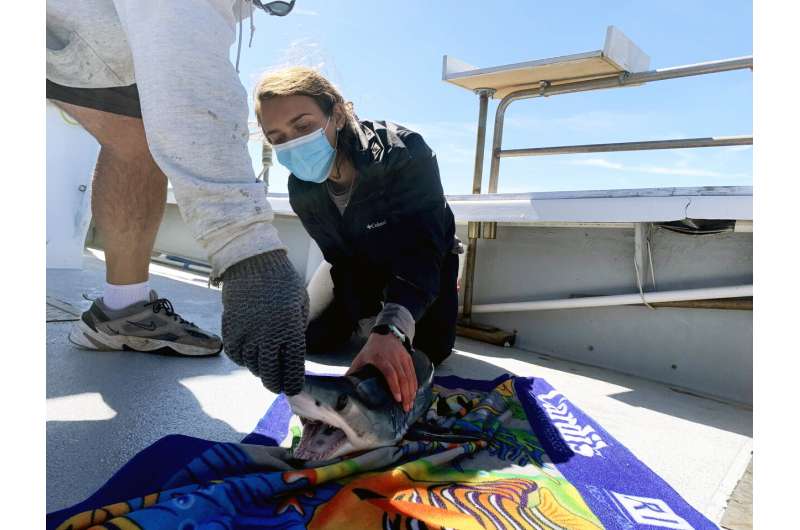URI graduate student Maria Manz handles a mako shark during a shark research trip in 2020. Credit: Brad Wetherbee
University of Rhode Island shark expert Brad Wetherbee has been tagging mako sharks up and down the East Coast for nearly 20 years and tracking their migratory movements around the North Atlantic. That data is now proving useful in a study aimed at improving the management of this imperiled species.
Mako sharks are among the fastest fish in the ocean, and they travel great distances throughout the year, seldom spending long in the waters of any one nation. That's why, according to Wetherbee, managing the species is so difficult. No nation wants to take responsibility for a species that is already considered globally overfished.
Using Wetherbee's tracking data, which was collected in collaboration with the Guy Harvey Research Institute, graduate student Maria Manz will soon be able to point the finger at which nation should take charge.
By analyzing 60,000 data points indicating the locations of tagged mako sharks, Manz will be able to identify in which jurisdictional waters the sharks spend most of their time and at what time of year. She can even break down that data by the sex of the sharks, which could be vital since females are more important to the health of the species than males.
"I'm looking at the relative proportion of detections per jurisdictional boundary to tell us what country has the most detections in their waters," said Manz, a native of Titusville, New Jersey, who earned a bachelor's degree from Moravian College. "The goal is to identify which country should allocate their resources to mako management, or, if most of their movements are in international waters, if an international governing body should come together to come up with a uniform law."
Manz is also using the data points to identify what she calls "highly utilized areas" along the East Coast—regions where mako sharks spend considerable amounts of time—and comparing those areas to conservation zones like marine protected areas and sites designated essential fish habitat.
"We want to see how they align," she said. "If areas highly utilized by the sharks are outside these marine protected areas, then that isn't great. If they don't align, you might question whether that protected area can protect mako sharks."
In addition, Manz is assessing how mako shark movements intersect with recreational fishing areas and planned offshore wind development regions along the East Coast.
"The theory is that wind farms will create artificial reefs that will be attractive to sharks, just like oil rigs do in the Gulf of Mexico," Manz said. "It's been hypothesized that these new reefs could become highly productive areas that could affect the migratory patterns of the sharks."
Finally, Manz is using the tracking data to estimate the size of the sharks that visit particular areas to determine the success of a 2019 rule about the minimum size limit of mako sharks that are allowed to be kept by recreational fishermen. The National Oceanic and Atmospheric Administration rule increased the length of mako sharks allowed to be kept to 71 inches for male sharks and to 83 inches for females. The objective is to determine whether the change in the size of sharks that can be retained has affected their distribution and abundance.
"All of this is designed to provide useful information about things that people don't have a good idea of," Manz said. "We have this great data set for providing information to stakeholders and fishery managers, but no one has looked at it like this before. Now they'll be able to use this information to base decisions on and to decide what other studies need to be done."
More information: To view the tracks of some of the tagged mako sharks, visit www.ghritracking.org.
Provided by University of Rhode Island
























